
With my family at the finish.
I’ve decided to sit on my experience for a solid 4 weeks before attempting to recap Saint George. There’s been a lot for me to process mentally, and a lot of recovery both physical and mental. In an attempt to share perhaps helpful info for runners signed up for (or interested in signing up for) Saint George Marathon, this blog is focused on the race experience – the course, organization, city, weather, and so on. In another blog I’ll share the personal stuff. If you aren’t aware (spoiler alert), I ran the marathon 6 weeks pregnant and it was 100% not the race I’d hoped it to be.
Saint George, Utah is an incredibly beautiful part of the country. I flew into Las Vegas and then made the 2 hour drive with my family to Saint George. The logistics were pretty easy, and it’s advised to drive into high elevation versus simply flying into it. As a New Yorker, I’m essentially at sea level most of the year. Saint George is at about 2500 ft and the starting line is up around 5000 ft.
I’m all about simplicity and low stress for a goal marathon, and so I booked the Hyatt in Saint George, which literally shared a parking lot with the Convention Center – the home of the race expo. An unexpected bonus: there’s a paved running/bike path and was right outside my hotel door, perfect for that shakeout run. The hotel has an outdoor pool and hot tub, and a tiny gym in case you need space to stretch, foam roll, etc.
The race expo was super easy. For the folks interested, there were the usual vendors marathoners expect. Personally, I usually just want to get in, get my stuff, and get out. Energy can be wasted at expos, it’s not advisable to try new snacks the day before a race, and I find the crowds often overwhelming. With this being my first elite bib, I had to bring my personal water bottles to the expo with me. I dropped my bottles off with volunteers (they’d be placed on the course the next day) and retrieved my bib from a special area. Otherwise it was the standard expo procedure.
For carb loading, there is a pasta dinner hosted at the Expo. However, there’s also a Cracker Barrel across the street, and so I opted for pancakes. Post-marathon we enjoyed steaks at Rib and Chop, and we also indulged our East Coast senses with In ‘n Out Burger a few times.
The day before the marathon, my family and I hopped in the rental car and drove the full race course. It was incredibly helpful to get a visual and to get the elevation profile under my belt. The downhills were generous and steep, but so were some of the climbs. The big reality check was Veyo, mile 7, where you climb for over a mile – at one point there’s a sign about an 8% grade up for vehicles. There was also a notable climb around mile 19 – which reminded me a little of Heartbreak Hill in Boston. Completing the drive left me feeling cautiously optimistic about the next morning. The course played into my strengths, and I was excited to blow my PR out of the water. I’d trained incredibly hard, pretty darn smart, and felt confident that the course and I were a really good match.
Race morning I awoke at 3am. With it being a point-to-point course, all marathoners had to board the buses at the finish line and be bussed up to the starting line. Multiple emails had been sent over the months stressing the boarding time ranged from 3:45am-5:20am – as the buses would be literally driving on the marathon course and needed to be cleared for the 6:45am start. Not one to be late or compromise my goal race, I was on the bus around 4:15am. There were no crowds waiting to board, and it was an incredibly smooth morning. Chris drove me the 3 miles from the hotel to the bus, I hopped on the bus, and off to the starting line I went. The bus ride was about 40 minutes, and I was at the starting line by 5am.
Upon arrival at the starting line, it was raining. The rain in the forecast was predicted to clear by 7:30am. However, this meant standing around in 45 degrees and rain for a few hours. I was a little surprised and disappointed to discover that elites were not given a tent. We were given our own area with our own porta-potties, but we were out in the elements like everyone else. While this was my first elite bib, to the best of my knowledge, elites at most races are given shelter from the elements. Luckily, I was prepared with extra clothes and volunteers handed out Mylar blankets – which are water proof.
The rain continued up until the starting of the marathon, and we passed the hours of waiting hanging out by fire pits, hopping into the porta-potties, and making small talk with each other. As it neared 6:45am, it was announced that the start would be delayed by “10-15 minutes.” I was really surprised, as Saint George Marathon has a reputation and brags about being one of the most organized marathons in the country. I was not thrilled to stand around in cold rain for additional time. The 10-15 minutes eventually turned into 30 minutes – and it was poorly communicated how and when we’d start. The reason for the delay: runners were late to board the last bus. The New Yorker in me was pretty pissed. It was clearly stated that the last bus would leave at 5:20am, and apparently the last one didn’t actually leave until 6:20am – A WHOLE HOUR BEHIND SCHEDULE.
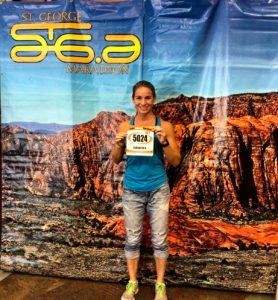
Bib pickup at the Expo
Once we did start, at 7:15am, it was still dark and raining. The road was wet and my shoes splashed through puddles. The sun rose on a fast and mostly downhill 10K. I knew about this potential trap and relaxed and just tried to wake up my legs. At mile 7 you hit Veyo – the first opportunity for spectators and crowd support, and that big monster hill. It’s then a gradual climb until mile 12. Mile 12-19 is practically all downhill. Some parts are steep, others definitely more gradual, and there were a few little climbs in the mix. Mile 16, Snow Canyon, offers the next big spectator opportunity. By this point, the rain had stopped and I could begin to take in the grandeur of the course. Aside from Mile 19, you continue to descend to Saint George. Once in Saint George, its residential and there are a few turns. The road flattens out and you can see the finish line for probably 800-600M before you cross the line.
A few takeaways:
- Train for hills – up and down. This kind of course can be absolutely relentless. The soreness after a flat marathon is nothing compared to a hilly one.
- Being elite, a volunteer was ready with my bottle in hand as I’d come through. This was really nice. A volunteer perhaps 200M from the hydration station would radio in my bib number so that the person at the table would be ready for me.
- The course is really beautiful and fast if you’re ready for it. It’s definitely a negative-split course on a good day.
- Everyone in Saint George was incredibly nice and supportive. The hydration volunteers yelled how much they loved my bottles (they were by far the best decorated!).
- Expect temperature at the start to be VERY different than the finish and dress/prepare accordingly.
- There’s no tree coverage or shade. For me, it was either raining or overcast. But I know in years past, if its a sunny day, runners have baked out there on this race.
- For the love of God, get to the busses extra early. That extra 30-60 minutes of sleep will not change your race day, but you may delay the race for literally 8,000 people.
- Having family on the course is always a boost, even on a bad day.
- Saint George is absolutely a race I’d recommend to marathoners.
Take note that unlike most marathons, Saint George always takes place on a Saturday. I assume this is for religious reasons (Utah is mostly Mormon) so be prepared to adjust travel plans if you are used to Sunday races.
 As most have heard, the weather on Patriot’s Day was anything but kind. Marathoners are pretty tough people, and Monday demanded our mental strength to carry when our bodies succumbed to the elements. I often preach to my runners that they need to learn to train in most elements because we never know what we’ll be handed by Mother Nature on race day. Monday was a reminder of that. Not surprisingly, the runners I know who preformed best were the Winter Warriors and the Ultra Marathoners.
As most have heard, the weather on Patriot’s Day was anything but kind. Marathoners are pretty tough people, and Monday demanded our mental strength to carry when our bodies succumbed to the elements. I often preach to my runners that they need to learn to train in most elements because we never know what we’ll be handed by Mother Nature on race day. Monday was a reminder of that. Not surprisingly, the runners I know who preformed best were the Winter Warriors and the Ultra Marathoners.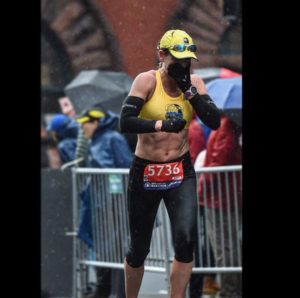 My calves felt like they were on the verge of cramping due to the cold around mile 14. I did everything I could to prevent cramping from happening, which meant changing my stride, form and pace in the late miles. I knew I was better off adding a minute to each mile than cramping and needing walk and stretching breaks in the elements. At the finish, I could barely lift my legs. My hips were in incredible pain, so cold and tight, and I wasn’t confident I’d make it to my hotel without a wheelchair ride to medical. Marni and the cup of hot cocoa at the finish line were the only reason I didn’t end up in a wheelchair.
My calves felt like they were on the verge of cramping due to the cold around mile 14. I did everything I could to prevent cramping from happening, which meant changing my stride, form and pace in the late miles. I knew I was better off adding a minute to each mile than cramping and needing walk and stretching breaks in the elements. At the finish, I could barely lift my legs. My hips were in incredible pain, so cold and tight, and I wasn’t confident I’d make it to my hotel without a wheelchair ride to medical. Marni and the cup of hot cocoa at the finish line were the only reason I didn’t end up in a wheelchair.
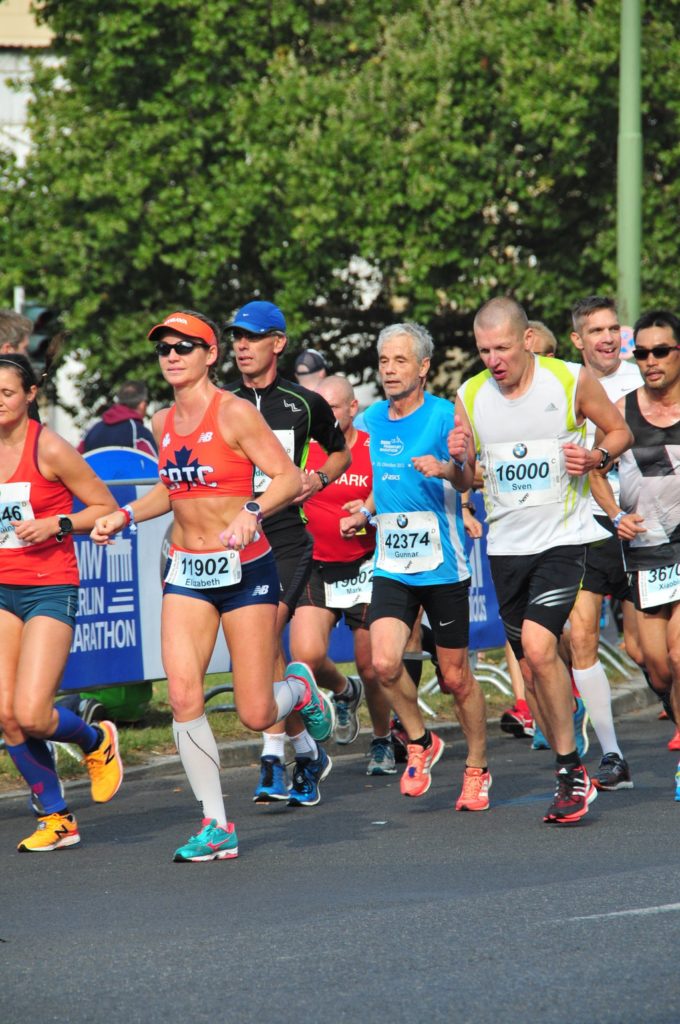

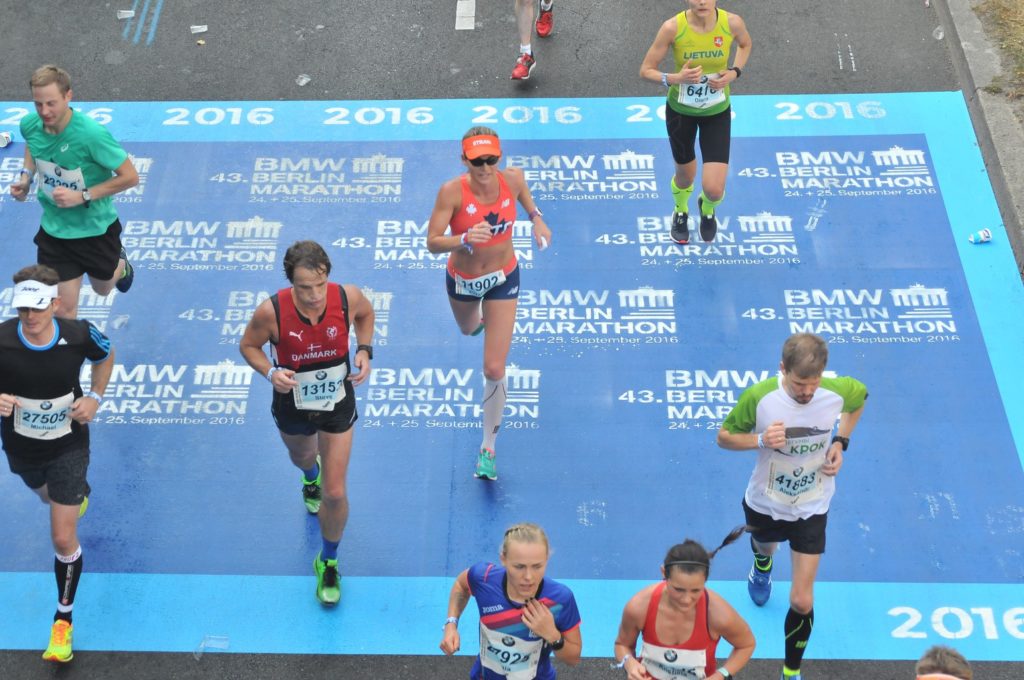

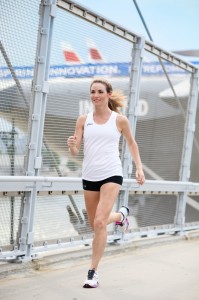 It’s been a hot second since my last blog post. I feel like I blinked, and we went from the end of 2015 to Spring 2016. My apologies, fellow runners and devote readers! I promise my posts will be back on track. There have been some big changes here – both personal and professional. If you are a New Yorker, you know that moving is perhaps the worst thing ever. Well, I’m happy to say I have found an amazing apartment, but am now in the downsizing and packing process. I am reminded when stress strikes to take a deep breath and go for a run. I always feel better. So if you are dealing with life stress, remember that 30-60 minutes to go clock some miles will always do your body, brain and happiness some good.
It’s been a hot second since my last blog post. I feel like I blinked, and we went from the end of 2015 to Spring 2016. My apologies, fellow runners and devote readers! I promise my posts will be back on track. There have been some big changes here – both personal and professional. If you are a New Yorker, you know that moving is perhaps the worst thing ever. Well, I’m happy to say I have found an amazing apartment, but am now in the downsizing and packing process. I am reminded when stress strikes to take a deep breath and go for a run. I always feel better. So if you are dealing with life stress, remember that 30-60 minutes to go clock some miles will always do your body, brain and happiness some good.


